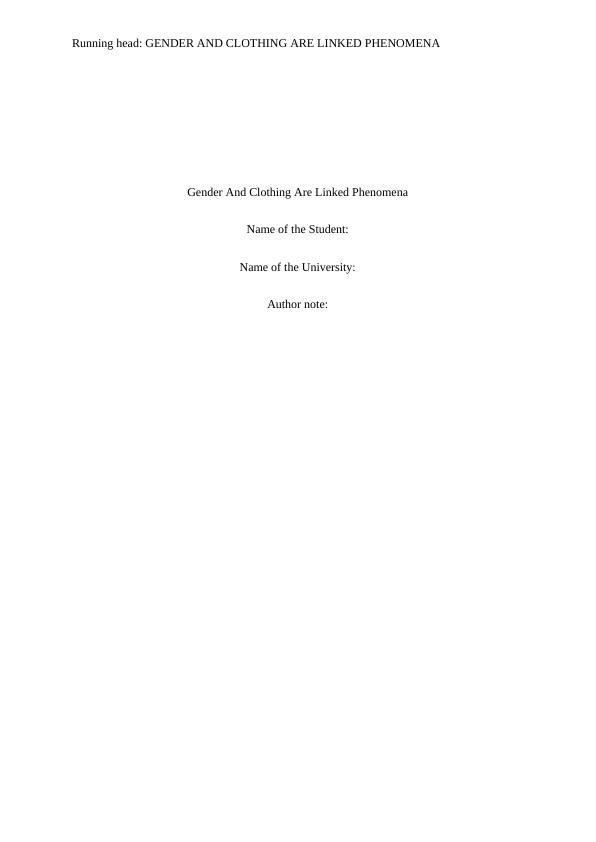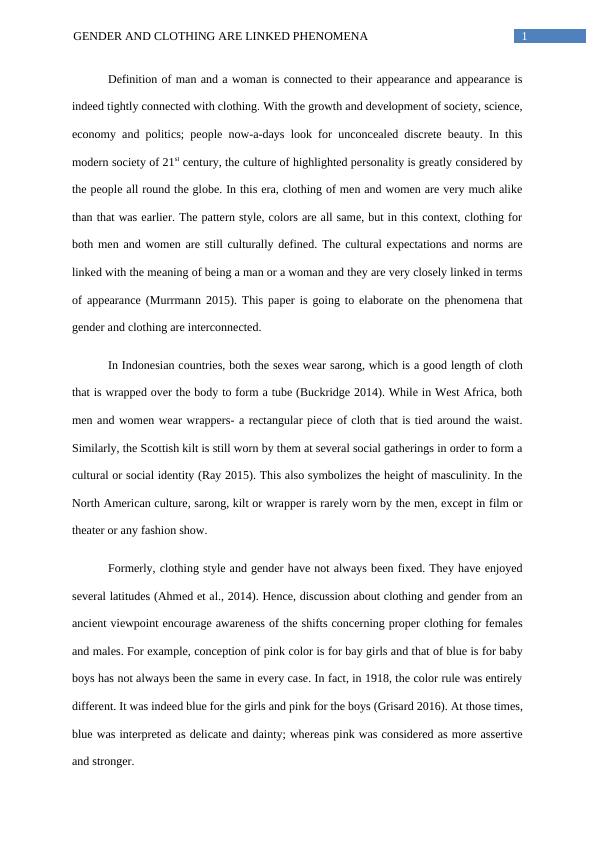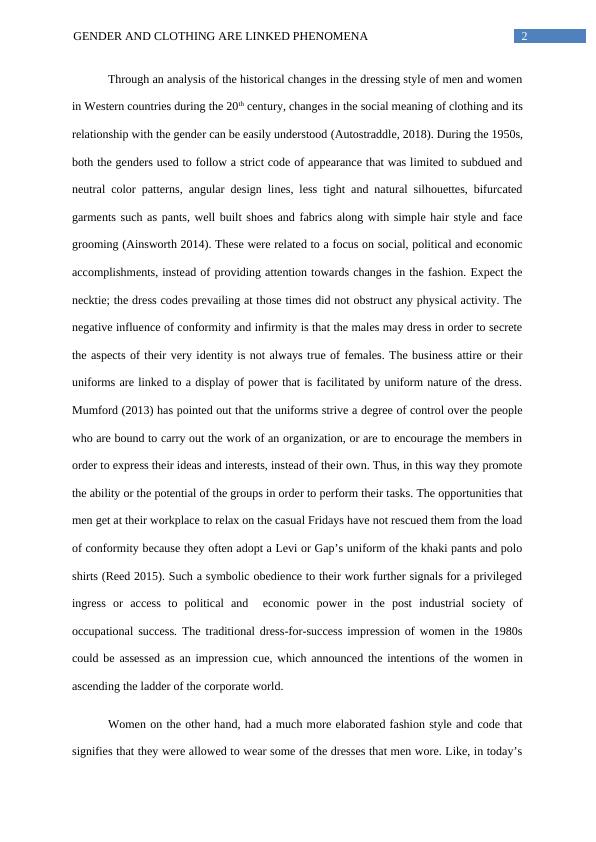Gender and Clothing Are Linked Phenomena
Added on 2023-06-13
8 Pages2241 Words404 Views
Running head: GENDER AND CLOTHING ARE LINKED PHENOMENA
Gender And Clothing Are Linked Phenomena
Name of the Student:
Name of the University:
Author note:
Gender And Clothing Are Linked Phenomena
Name of the Student:
Name of the University:
Author note:

1GENDER AND CLOTHING ARE LINKED PHENOMENA
Definition of man and a woman is connected to their appearance and appearance is
indeed tightly connected with clothing. With the growth and development of society, science,
economy and politics; people now-a-days look for unconcealed discrete beauty. In this
modern society of 21st century, the culture of highlighted personality is greatly considered by
the people all round the globe. In this era, clothing of men and women are very much alike
than that was earlier. The pattern style, colors are all same, but in this context, clothing for
both men and women are still culturally defined. The cultural expectations and norms are
linked with the meaning of being a man or a woman and they are very closely linked in terms
of appearance (Murrmann 2015). This paper is going to elaborate on the phenomena that
gender and clothing are interconnected.
In Indonesian countries, both the sexes wear sarong, which is a good length of cloth
that is wrapped over the body to form a tube (Buckridge 2014). While in West Africa, both
men and women wear wrappers- a rectangular piece of cloth that is tied around the waist.
Similarly, the Scottish kilt is still worn by them at several social gatherings in order to form a
cultural or social identity (Ray 2015). This also symbolizes the height of masculinity. In the
North American culture, sarong, kilt or wrapper is rarely worn by the men, except in film or
theater or any fashion show.
Formerly, clothing style and gender have not always been fixed. They have enjoyed
several latitudes (Ahmed et al., 2014). Hence, discussion about clothing and gender from an
ancient viewpoint encourage awareness of the shifts concerning proper clothing for females
and males. For example, conception of pink color is for bay girls and that of blue is for baby
boys has not always been the same in every case. In fact, in 1918, the color rule was entirely
different. It was indeed blue for the girls and pink for the boys (Grisard 2016). At those times,
blue was interpreted as delicate and dainty; whereas pink was considered as more assertive
and stronger.
Definition of man and a woman is connected to their appearance and appearance is
indeed tightly connected with clothing. With the growth and development of society, science,
economy and politics; people now-a-days look for unconcealed discrete beauty. In this
modern society of 21st century, the culture of highlighted personality is greatly considered by
the people all round the globe. In this era, clothing of men and women are very much alike
than that was earlier. The pattern style, colors are all same, but in this context, clothing for
both men and women are still culturally defined. The cultural expectations and norms are
linked with the meaning of being a man or a woman and they are very closely linked in terms
of appearance (Murrmann 2015). This paper is going to elaborate on the phenomena that
gender and clothing are interconnected.
In Indonesian countries, both the sexes wear sarong, which is a good length of cloth
that is wrapped over the body to form a tube (Buckridge 2014). While in West Africa, both
men and women wear wrappers- a rectangular piece of cloth that is tied around the waist.
Similarly, the Scottish kilt is still worn by them at several social gatherings in order to form a
cultural or social identity (Ray 2015). This also symbolizes the height of masculinity. In the
North American culture, sarong, kilt or wrapper is rarely worn by the men, except in film or
theater or any fashion show.
Formerly, clothing style and gender have not always been fixed. They have enjoyed
several latitudes (Ahmed et al., 2014). Hence, discussion about clothing and gender from an
ancient viewpoint encourage awareness of the shifts concerning proper clothing for females
and males. For example, conception of pink color is for bay girls and that of blue is for baby
boys has not always been the same in every case. In fact, in 1918, the color rule was entirely
different. It was indeed blue for the girls and pink for the boys (Grisard 2016). At those times,
blue was interpreted as delicate and dainty; whereas pink was considered as more assertive
and stronger.

2GENDER AND CLOTHING ARE LINKED PHENOMENA
Through an analysis of the historical changes in the dressing style of men and women
in Western countries during the 20th century, changes in the social meaning of clothing and its
relationship with the gender can be easily understood (Autostraddle, 2018). During the 1950s,
both the genders used to follow a strict code of appearance that was limited to subdued and
neutral color patterns, angular design lines, less tight and natural silhouettes, bifurcated
garments such as pants, well built shoes and fabrics along with simple hair style and face
grooming (Ainsworth 2014). These were related to a focus on social, political and economic
accomplishments, instead of providing attention towards changes in the fashion. Expect the
necktie; the dress codes prevailing at those times did not obstruct any physical activity. The
negative influence of conformity and infirmity is that the males may dress in order to secrete
the aspects of their very identity is not always true of females. The business attire or their
uniforms are linked to a display of power that is facilitated by uniform nature of the dress.
Mumford (2013) has pointed out that the uniforms strive a degree of control over the people
who are bound to carry out the work of an organization, or are to encourage the members in
order to express their ideas and interests, instead of their own. Thus, in this way they promote
the ability or the potential of the groups in order to perform their tasks. The opportunities that
men get at their workplace to relax on the casual Fridays have not rescued them from the load
of conformity because they often adopt a Levi or Gap’s uniform of the khaki pants and polo
shirts (Reed 2015). Such a symbolic obedience to their work further signals for a privileged
ingress or access to political and economic power in the post industrial society of
occupational success. The traditional dress-for-success impression of women in the 1980s
could be assessed as an impression cue, which announced the intentions of the women in
ascending the ladder of the corporate world.
Women on the other hand, had a much more elaborated fashion style and code that
signifies that they were allowed to wear some of the dresses that men wore. Like, in today’s
Through an analysis of the historical changes in the dressing style of men and women
in Western countries during the 20th century, changes in the social meaning of clothing and its
relationship with the gender can be easily understood (Autostraddle, 2018). During the 1950s,
both the genders used to follow a strict code of appearance that was limited to subdued and
neutral color patterns, angular design lines, less tight and natural silhouettes, bifurcated
garments such as pants, well built shoes and fabrics along with simple hair style and face
grooming (Ainsworth 2014). These were related to a focus on social, political and economic
accomplishments, instead of providing attention towards changes in the fashion. Expect the
necktie; the dress codes prevailing at those times did not obstruct any physical activity. The
negative influence of conformity and infirmity is that the males may dress in order to secrete
the aspects of their very identity is not always true of females. The business attire or their
uniforms are linked to a display of power that is facilitated by uniform nature of the dress.
Mumford (2013) has pointed out that the uniforms strive a degree of control over the people
who are bound to carry out the work of an organization, or are to encourage the members in
order to express their ideas and interests, instead of their own. Thus, in this way they promote
the ability or the potential of the groups in order to perform their tasks. The opportunities that
men get at their workplace to relax on the casual Fridays have not rescued them from the load
of conformity because they often adopt a Levi or Gap’s uniform of the khaki pants and polo
shirts (Reed 2015). Such a symbolic obedience to their work further signals for a privileged
ingress or access to political and economic power in the post industrial society of
occupational success. The traditional dress-for-success impression of women in the 1980s
could be assessed as an impression cue, which announced the intentions of the women in
ascending the ladder of the corporate world.
Women on the other hand, had a much more elaborated fashion style and code that
signifies that they were allowed to wear some of the dresses that men wore. Like, in today’s

End of preview
Want to access all the pages? Upload your documents or become a member.
Related Documents
Sociology of Gender and Sexualitylg...
|11
|1932
|458
Short Writing Assignment - Exampleslg...
|4
|589
|12
